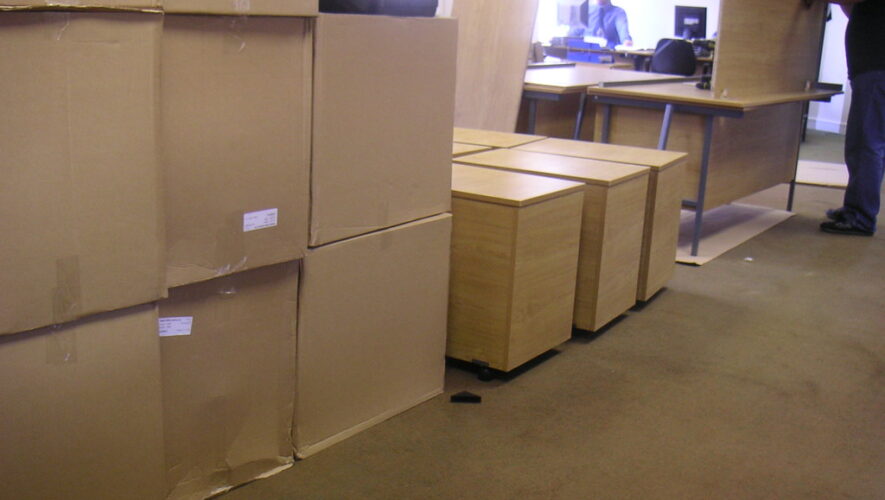Moving your office is one of the most stressful and challenging things that a business owner can do. But with the right planning, it can be done without too much upheaval to your business. Here are some tips for reducing stress levels when moving into a new office location:
Plan ahead to save yourself time and trouble.
The first thing to do is assess the situation.
- What do I have to move? Is it a lot of items or just a few?
- How much time have I got available for this task? Have I got any other commitments (work, home etc) that are going to get in the way of my moving plans.
Once you know what needs to be done, then it’s time to plan out your moving strategy for a seamless business relocation:
- Which items need collecting from where and when? There’s nothing worse than spending all day driving back and forth trying to find stuff. If an item has been left somewhere that you don’t have access too, try calling them up and asking them if they could bring it over as soon as possible.
Book a mover far enough in advance.
It can be tempting to book a mover on the day you need it—it’s a big relief when you think everything is taken care of, and you don’t want to wait. However, booking your mover too early in advance means that they won’t have as many options available for dates and times. Booking far enough in advance will help ensure that the movers are available and have plenty of time to fit your move into their schedule. If this isn’t possible because of limited availability in your area, try booking a few weeks ahead or at least two weeks before until something becomes available for your moving day.
Decide what you’re taking to the new office.
- Think about what you need to take with you and what can be left behind.
- If you’re moving into a smaller space, consider investing in a few pieces of furniture that will maximize the space and make it feel more like home.
- Consider joining a co-working space for some time before finding a permanent office.
Book time off from work, and brief your staff.
The first step to reducing stress is to get things done. This can be a bit daunting, as you will probably have a lot of work to do and not enough time, but it’s important that you stay focused on the task at hand. If you try and move everything out of your office at once then you’re going to end up spending all day in your new building, which isn’t very productive! So instead of trying to move everything out all at once, take smaller steps and just focus on one thing at a time: whether that be packing up electronics or moving furniture around or whatever else needs doing.
Once all this is done (and hopefully with minimal effort), then go through what remains in your old office space and ask yourself whether there really needs to be anything left behind before moving day arrives.
Declutter your office before moving day.
The first thing to do is to declutter your office. You should get rid of unnecessary items such as old paperwork, unused supplies, and other things that are just taking up space in your office. Don’t forget to clean out your desk drawers as well and empty filing cabinets and storage cabinets if you have them. This will make it easier for the movers when they come in on moving day since they won’t have to worry about getting stuck behind a pile of paper or boxes.
Pack carefully and label everything.
- Pack carefully and label everything. The first step to a smooth move is to pack your stuff up properly. To help with this, be sure to:
- Label all of your boxes as clearly as possible so that you can find what’s inside quickly and easily. For example, you should mark the box “Kitchen Stuff” or “Bedroom Stuff” on the outside of the box so that it stands out from others in storage if you have multiple people sharing a space with different rooms designated for specific uses!
As an added bonus, labeling also helps keep things organized during transit so that they won’t get mixed up with other peoples’ belongings when moving from one location to another (which would cause confusion).
Let your clients know about your office move as soon as possible.
It’s important to let clients know about your office move as soon as possible. It can be tricky to find out who all your clients are, especially if you work with a lot of different companies or individuals. It’s also important that you inform them of the best way to contact you once they have gotten details on where exactly your new office is located, so they can reach out if needed.
It’s best to give yourself time between when the move takes place and when it’s publicized by sending an email with a friendly message about the change (i.e., “We’ve moved! Our new address is _____”). If this is going to affect any clients negatively, be sure not only include contact information but also apologize for any inconveniences caused by this change!
Visit your new office location beforehand.
If you have a new office location, take time to visit it beforehand and check out the parking situation. Is there ample space for everyone? Are there plenty of visitor spots and handicapped parking available? If any of your staff members are expecting to bring their cars, make sure they know where they can park.
Also check out the area around your new building—do you have everything within walking distance that you need (e.g., shops, restaurants) or will people have to rely on cabs or public transportation? Is there enough seating inside the office or do people need to go outside to eat lunch together if they want privacy?
Update information about office relocation with others.
- Update information about office relocation with others.
- Update your website and other online information.
- Update your email address, business cards, social media accounts and phone number.
- Update your contacts list in Outlook or Gmail to reflect your new location.
Get everyone involved in the move to reduce stress levels.
You can reduce stress levels by involving your entire team in the relocation.
- Make sure everyone knows about the move and how it will affect them, so they can prepare for it.
- Get your moving crew to help with packing, unpacking, and unpacking after all goods are delivered so that you don’t have to do everything yourself (which will increase your stress levels).
- Involve clients in the move too – let them know what to expect from you when moving day comes around.
Hire a reliable office mover with experience.
Hiring a good mover is one of the best ways to reduce the stress of moving. A reliable office mover, like Halton removals in Dublin, will be experienced in handling your office moves, so they know what to expect and how to handle any problems that arise. You want to hire a company that has a good reputation and is well-known in your area. This ensures that your move will go smoothly with no surprises along the way.
A reputable company will have its own insurance policy, so their liability for damage or loss during transit is covered. They should also have transportation licenses for both passengers and cargo transport vehicles, which are necessary if you plan on hiring them for interstate or international moves (which most businesses do).
Put together an essentials box for moving day and beyond.
Make sure you have the following items on hand:
- scissors
- tape (packing tape or duct tape)
- a box cutter or utility knife to open boxes, if necessary
- a digital scale (if necessary) for weighing your boxes, which helps with calculating the costs of shipping them separately from your inventory
Moving offices amounts to a huge change for any business, but proper planning will keep things running smoothly without adding too much stress to the mix
Moving offices amounts to a huge change for any business, but proper planning will keep things running smoothly without adding too much stress to the mix. Here are 12 ways to reduce office moving stress:
- Book a mover in advance. The best way to handle an office move is by hiring professionals who always do this and know exactly what they’re doing. Don’t skimp on this expense—it’ll be worth it when your belongings arrive at their destination safely and before your new employees start work on Monday morning.
- Book time off from work. If you have staff, everyone will likely want some time off after moving into their new space—they may even want two or three days off! Make sure there’s enough flexibility in each employee’s schedule to take as much time as they need (and deserve) after such a big transition (you can also offer paid days off).
- Declutter before moving day. When preparing for an office move, decluttering is key because it allows more space while reducing clutter and helping prevent accidents during transit—and if something does get damaged or lost during the move, replacing it will cost less than trying to salvage what was already there!
Conclusion
Moving your office is an exciting time, but it can also be stressful. By taking some time to plan ahead and prepare for this change, you’ll minimize the hassle of the moving day and relocate your business with ease.



